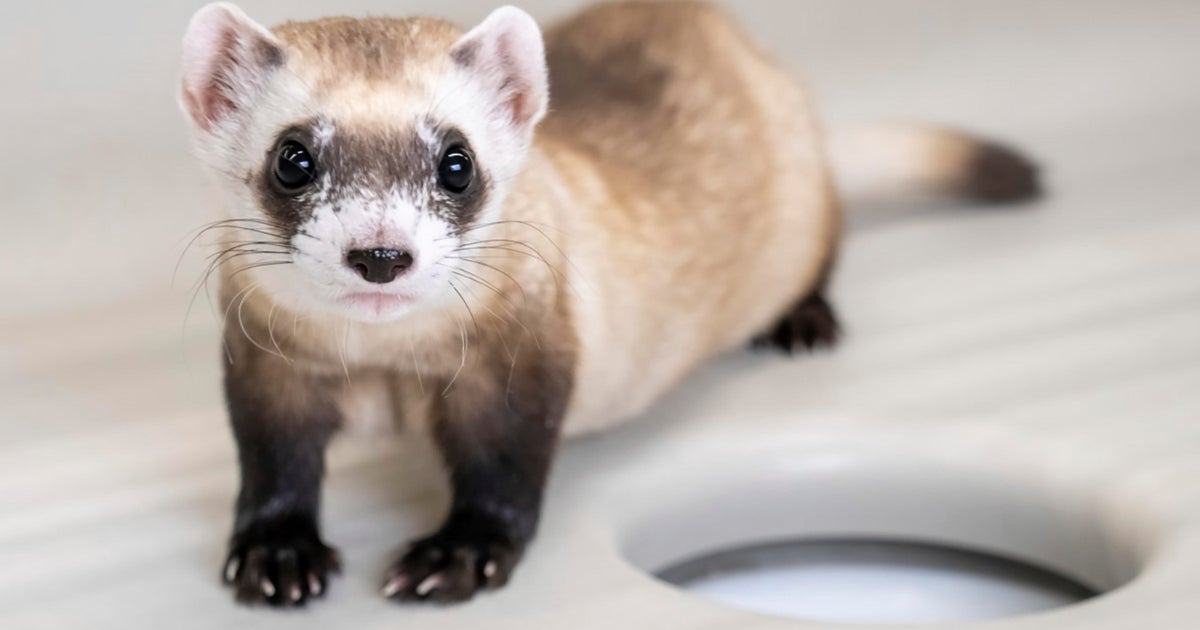In Search of the Jaguar: Up Close and Rare
Editor's Note: Dr. Alan Rabinowitz, who devoted his life to protecting jaguars, died of cancer this week at 64. In 2010, he took Bob Simon on an adventure deep into the Brazilian jungle in search of the elusive cats. The two men had what Dr. Rabinowitz called "unbelievable luck" in their pursuit.
We name fancy cars and sports teams after them, but precious few people have ever seen a jaguar in the wild. They don't live in the United States anymore and can only be found in the sweltering jungles of Central and South America. But just try to find one - they hunt by night and sleep by day, comfortably concealed in thick, dark brush.
It's because of their elusive nature, their power and their beauty, that jaguars have long been worshipped by tribes as demigods, whose real home is a spiritual world which man cannot even fathom. But whichever world they frequent, they only emerge -- briefly -- during the dry season when they go down to rivers to drink.
So when it got dry last year and Dr. Alan Rabinowitz, the world's foremost authority on jaguars, invited us to go with him to some far flung wetlands in Brazil, near the Bolivian border, we picked up the phone and booked our flights.
Bob Simon's Wild Kingdom
When it comes to the world of foreign reporting, Bob Simon has been everywhere and seen everything. But it turns out he has a soft spot when it comes to the plight of threatened wildlife. And don't get him started on baby elephants.
Photos: Finding Jaguars in Brazil
Segment: In Search of the Jaguar
We headed towards an unspoiled, remote area called the Pantanal, where the temperature rarely dipped below 115 degrees. We had to cross more than 125 rustic wooden bridges over dried up ponds and lakes, home to piranhas and caimans, cousins of the crocodile. It was good to be in a car.
We started our search for jaguars on the Cuiaba River with Alan Rabinowitz, the CEO of Panthera, a new conservation group. He told us that jaguars are very fast and have been known to kill people. It was good to be in a boat.
Rabinowitz has been studying the cats' migration routes and habitats in the jungle for 30 years. But he has gone months without seeing a single one. His advice to us: get lucky.
"It takes hours and hours of doing this because even when they're out there, it's almost [like a] needle in a haystack," he told correspondent Bob Simon. "Even though this is the densest, highest concentration of jaguars matching any place on Earth, there's still a limited number of jaguars here."
But luck was a lady that day: it wasn't long before we caught our first glimpse -- and it was just a glimpse -- of a young jaguar, sitting on the river bank behind a fallen tree.
He was difficult to see, but Rabinowitz spotted him. "Its head is right there. Amazing, see it? You got it, it's beautiful. See it? Isn't that something? This gives you the real gut feel of the secretive nature of this animal," he said.
"There's no sign of defeat in its face," Rabinowitz added.
At dawn the next day, we went looking for jaguars again. One of our spotters tried to tempt the cats out of the jungle, but his simulated mating call just didn't do it.
But it might have appealed to anacondas. One anaconda we came across, according to the spotters, was nine feet long. Then we went up a small river that looked like an aquatic Garden of Eden -- no jaguars there either, but an extraordinary assembly of birds and others creatures.
We saw a family of very rare giant river otters, basking in the sun after a morning of fishing and swimming. We saw the world's largest rodents, unflappable hundred pound capybaras, a favorite dish of jaguars. Jaguars like caimans as well, as we saw from evidence of past meals.
Photographer Steve Winter has been a jaguar groupie for years and was helping us look for the cats. He has shot what could be the finest jaguar portraits ever taken. They weren't easy to come by.
"I spent the first three months in the jungle and got a big fat zero," he remembered. "No cats."
Asked how he felt about his three-month jaguar dry spell, Winter told Simon, "I felt like my career was over."
We were beginning to feel the same way, so we headed out again at night. Our spotters told us they could see the reflection of their lights in the eyes of a jaguar a hundred yards away. We were skeptical. We were wrong.
"That's like 80 to 85 kilos, a relatively small jaguar," Rabinowitz said, pointing out a jaguar on the riverbank only 30 feet away. "Look at her, God, she's beautiful, oh man and then she looks right at you."
"It's one of the most beautiful things I have ever seen," Simon remarked.
"This is just such an amazing sight," Rabinowitz said. "This one was a great sighting."
But the best was yet to come: a few minutes later, we happened to be there as a jaguar swam from one side of the river to the other. It was a once-in-a-lifetime shot in the dark.
"This is a rare sight. I've never seen them in the water. I've never gotten them in the water before," Rabinowitz said.
Rabinowitz, a zoologist, scholar and scientist, was as excited as a kid at the zoo. Perhaps more excited. "That was spectacular. I've never seen that before. What luck, what unbelievable luck, just as it's swimming across!" he remarked.
"There was no fear there. There was just pure curiosity. Like, 'What are you guys bothering me about?'" he added, laughing.
Maybe we had bothered her because she disappeared. But then, it seems, she got curious again and came back.
"Look at that, it's just sitting there on the mound, yes, just sitting there. It's phenomenal," Rabinowitz pointed out.
She looked a little sleepy or confused. But there she was, the diva, perfectly lit, taking her curtain call. It was hard to imagine that this lovely starlet was really a ferocious predator who sinks her fangs into the skull of her prey, killing it instantly. We were beginning to understand why jaguars were viewed as otherworldly beings by the tribes that used to live in the jungle.
Because he is a creature of the night, his real home is said to be the underworld, which he dominates, just as he dominates the jungle. Killing a jaguar is believed by some tribes as being the equivalent to killing an ancestor, and is said to condemn the killer to eternal damnation. That myth has helped the jaguar survive.
And in the strangest way, jaguars helped Rabinowitz survive. It all began with a debilitating condition he suffered even before he knew what a jaguar was.
"When I was a young child, I couldn't speak. I had a severe, severe stutter," he told Simon. "I could talk, but I had severe blocks. My whole body would spasm. My mouth would close shut. And back then, unlike now, they thought it was completely psychological. Now we know it's more genetic. So they would put me in special classes. They would put me in what all the kids called the 'retarded classes.' And I just stopped trying. I stopped even trying to speak to the human world. What I could do - stutterers can sing without stuttering -- and I couldn't sing very well. And stutterers can speak to animals. And every day, I'd come home from school and I'd go into my closet, because I loved being in the dark. And I'd speak to my green turtles or chameleons or lizards or garter snakes. If I was having a particularly bad week at school, which often happened, my father would take me to the Bronx Zoo."
And that's where his fascination, his obsession, began: in the Bronx Zoo.
"One pitiful, lone jaguar sat in the great cat house. It was big, it was powerful. And it was all alone. And I was so incredibly attracted to that one lone jaguar. I would make my father stay back and I would lean over towards the bars and I would start talking…to the…jaguar. I did talk to the jaguar," Rabinowitz remembered.
Asked if he remembered what he said, Rabinowitz told Simon, "I would say how people are stupid, how they don't understand me. Clearly, the same way they don't understand you, how they're locking you up in this cage the way I'm locked up in my own head. Those are the things I would talk about to the jaguar. I made a promise over and over again that if I ever got my voice back that somehow I would help that animal. Help that jaguar, help these animals like him."
Rabinowitz has kept his promise. Devotion to jaguars became his religion.
Before he got married, he lived alone in the jungle just to be close to jaguars, doing then what he does now: learning more about them every day.
Rabinowitz sets up traps to temporarily capture the jaguars so that he can attach radio collars to their necks. One night, Rabinowitz and his team snared a young lady and put her to sleep for a while.
"This is the same cat we saw swimming this afternoon, is it?" Simon asked.
"It's likely. It looks as if it probably is," Rabinowitz said.
The team monitored the jaguar's vital signs, took a blood sample and put a GPS unit around her neck.
"It's through the data of a few animals like this that we're able to be saving this whole species," Rabinowitz explained.
There was also a jaguar we spotted from the sky. The data Rabinowitz has collected showed him that jaguars instinctively travel great distances, sometimes hundreds of miles.
Trouble is, they can't anymore: cattle ranches now interrupt their old roaming routes. And ranchers kill them because jaguars eat their cattle.
That's where billionaire Tom Kaplan, the co-founder of Panthera, the outfit trying to save jaguars, comes in. He's buying up ranches and telling the ranchers -- his employees now -- to lay off the jaguars.
To make sure they understand that there's been a change of ownership, he's introduced a new branding iron: the paw print of a jaguar.
He's also winning them over the old fashioned way, by improving their lives, building schools and clinics.
"There is no better way to stop poaching than to make the local community say, 'Hey, wait a minute, our children have medicine and education because of the jaguar.' When you show that, you've won their hearts and you've won their minds and then you've won the war," Kaplan explained.
Rabinowitz wants the jaguars to be able to roam freely again, so he's working with governments as well as ranchers to protect what he calls jaguar corridors. They connect the different isolated areas where the cats are still thriving. He gets to these areas sometimes, and sometimes he gets too close.
"Now, how far away are you from him?" Simon asked about one close encounter.
"I would say about 20 feet," Rabinowitz remembered.
"And he is standing, sitting, lying?" Simon asked.
"He was standing. Then probably within a few seconds, I realized this is dangerous. And I fell. Of course, you know, what more could happen? So I fell backwards, thinking, 'Okay, if you wanna kill me, now's the time.' I'm on my back. And the jaguar just stood up and started walking off into the jungle. Not very far away," Rabinowitz remembered. "But this is what I'll never forget. It turned back to me, it gave a low growl. It wasn't an aggressive growl. It just gave kind of a low, growling sound, and it looked at me. And I looked at it. And I could look in its eyes now with no fear. And I said to it, I said out loud, 'We're okay now. We're gonna be okay.'"
Rabinowitz can only hope he'll be ok. He conquered his stutter but now he's fighting leukemia and doesn't know how much longer he'll be able to spend in the jungle.
But before we left, he told us he was happy that, after his 30 years of devotion, we'd be introducing so many of his friends on "60 Minutes."
Produced by Tom Anderson



